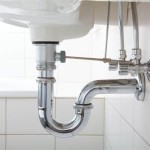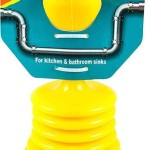How To Remove Bad Odor From Kitchen Sink
The kitchen sink, a vital component of any household, is frequently exposed to food particles, grease, and various other organic materials. This constant exposure creates an environment conducive to bacterial growth, often resulting in unpleasant odors emanating from the sink drain. Addressing this issue promptly is crucial not only for maintaining a clean and hygienic kitchen but also for preventing potential plumbing problems and health concerns related to unsanitary conditions.
Identifying the source of the odor is the first step in effectively eliminating it. The odor can originate from several locations within the sink system, including the drain, the garbage disposal (if equipped), the P-trap, and even the sink basin itself. A thorough inspection is necessary to pinpoint the specific area contributing to the problem. Once the source is identified, appropriate cleaning and maintenance methods can be applied to neutralize the odor and prevent its recurrence.
Understanding the Common Causes of Sink Odors
Several factors contribute to the development of unpleasant smells originating from the kitchen sink. The most common culprits include food debris accumulation, grease buildup, bacterial growth, and issues with the P-trap. Each of these factors requires a specific approach for effective remediation.
Food debris, such as small particles of fruits, vegetables, and meat, often gets trapped in the drain or garbage disposal. Over time, these particles decompose, releasing foul-smelling gases like hydrogen sulfide and methane. The presence of these gases is a primary cause of the characteristic rotten egg smell frequently associated with a problematic kitchen sink.
Grease and fats, when poured down the drain, solidify and accumulate along the interior walls of the pipes. This buildup restricts water flow and creates a sticky surface that attracts and traps even more food particles. The combination of grease and decaying food creates a breeding ground for bacteria and contributes significantly to persistent odors.
Bacteria thrive in the dark, moist environment of the sink drain. These microorganisms feed on organic matter and produce byproducts, including volatile organic compounds (VOCs), which are responsible for the unpleasant smells. Some types of bacteria, particularly sulfate-reducing bacteria, are especially notorious for producing hydrogen sulfide gas.
The P-trap, a U-shaped pipe located under the sink, is designed to trap water and prevent sewer gases from backing up into the house. If the P-trap dries out due to infrequent use or a leak, sewer gases can escape, leading to strong, offensive odors. Maintaining a proper water seal in the P-trap is essential for preventing this issue.
Effective Cleaning Methods for Eliminating Sink Odors
Several cleaning methods can be employed to eliminate bad odors from the kitchen sink. These methods range from simple home remedies using readily available ingredients to more intensive cleaning procedures involving specialized products. The choice of method depends on the severity of the odor and the underlying cause.
One of the simplest and most effective methods is flushing the drain with hot water. This helps to dislodge loose food particles and grease buildup. Running hot water down the drain for several minutes can often provide temporary relief from mild odors. To enhance the cleaning effect, adding dish soap can help to break down grease and further flush away debris.
Baking soda and vinegar, a classic combination for household cleaning, can be used to effectively deodorize the sink drain. Pouring a cup of baking soda down the drain, followed by a cup of vinegar, creates a chemical reaction that produces fizzing and bubbling. This action helps to loosen debris and neutralize odors. After allowing the mixture to sit for 30 minutes, flushing the drain with hot water will complete the cleaning process. This method is particularly effective for removing minor clogs and eliminating surface odors.
Boiling water can be used to melt away grease buildup and dislodge accumulated debris. Carefully pour a large pot of boiling water down the drain. This method is especially effective for addressing grease-related odors. However, caution should be exercised when using boiling water, particularly if the sink pipes are made of PVC, as excessive heat can potentially damage the pipes. For PVC pipes, using hot tap water is a safer alternative.
For sinks equipped with a garbage disposal, cleaning the disposal unit is essential for eliminating odors. Food particles often accumulate inside the disposal chamber, leading to bacterial growth and unpleasant smells. Grinding ice cubes in the disposal can help to dislodge built-up debris. Adding citrus peels, such as lemon or orange, during the grinding process can provide a refreshing scent. Additionally, using a specialized garbage disposal cleaner can help to break down grease and kill odor-causing bacteria.
In cases where the odor persists despite these cleaning efforts, a more thorough cleaning of the P-trap may be necessary. This involves disconnecting the P-trap, cleaning it out thoroughly, and then reassembling it. This procedure requires some basic plumbing knowledge and may necessitate the use of tools such as a wrench and a bucket to catch water. Before disconnecting the P-trap, ensure that the water supply to the sink is turned off.
Preventative Measures for Maintaining a Fresh-Smelling Sink
Preventing bad odors from developing in the kitchen sink is crucial for maintaining a clean and hygienic environment. Implementing preventative measures can significantly reduce the frequency of odor problems and minimize the need for intensive cleaning. Several strategies can be adopted to prevent the accumulation of food debris, grease buildup, and bacterial growth.
One of the most effective preventative measures is to avoid pouring grease down the drain. Instead, collect used cooking oil and fats in a container and dispose of them properly. Consider using a grease recycling service or solidifying the grease and discarding it with solid waste. Preventing grease buildup in the pipes significantly reduces the risk of clogs and unpleasant odors.
Scraping food scraps into the trash or compost bin before washing dishes minimizes the amount of food debris that enters the sink drain. This simple practice greatly reduces the amount of organic matter available for bacteria to feed on and prevents the formation of foul-smelling gases. Regular clearing of the sink strainer is also important to prevent accumulation of food particles.
Rinsing the sink regularly with hot water after each use helps to flush away any remaining food particles and grease. This prevents the accumulation of debris and minimizes the opportunity for bacteria to grow. Adding a small amount of dish soap to the hot water can further enhance the cleaning effect.
Periodically flushing the drain with baking soda and vinegar, even if no odor is present, can help to maintain a clean and odor-free sink. This preventative measure helps to dissolve minor clogs and neutralize any developing odors before they become noticeable. Performing this cleaning routine once or twice a month can significantly reduce the risk of odor problems.
Ensuring that the P-trap contains water is essential for preventing sewer gases from entering the house. If the sink is not used frequently, running water down the drain periodically can help to maintain the water seal in the P-trap. If the P-trap dries out frequently, inspecting for leaks and addressing any plumbing issues can help to resolve the problem.
For sinks equipped with a garbage disposal, running cold water while the disposal is in operation helps to solidify grease and prevent it from sticking to the sides of the disposal chamber. Also, avoid grinding large quantities of starchy foods, such as potato peels and rice, as these can contribute to clogs and odors. Regular cleaning of the garbage disposal with ice cubes and citrus peels can help to maintain its cleanliness and prevent odor formation.
By implementing these preventative measures, the likelihood of developing bad odors in the kitchen sink can be significantly reduced. Maintaining a clean and well-maintained sink not only improves the overall hygiene of the kitchen but also prevents potential plumbing problems and health concerns.

How To Remove Sink Odor With Baking Soda And Vinegar Zep Drain Defense Prevent

Deodorize A Kitchen Sink That Smells 5 Ways Youtube

How To Remove Musty Odors From Kitchen Sink Water Damage

How To Get Rid Of Kitchen Sink Odor Clean Garbage Disposal Stinky Natural Cleaning Solutions

How To Fix Smelly Sink Drains Using At Home Blockbusters

How To Clean A Stinky Sink Drain

12 Tips To Get Rid Of Smelly Sink Drain Odours Plumbwize

3 Ways To Keep Kitchen Drains Smelling Fresh Wikihow Life

How To Clean A Smelly Drain Liquid Plumr

How To Clean A Smelly Kitchen Sink Drain







